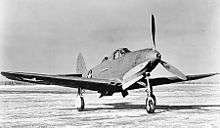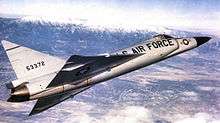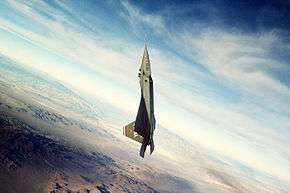478th Aeronautical Systems Wing
478th Aeronautical Systems Wing
 | |
|---|---|
|
YF-22 during a test flight | |
| Active | 1943-1944; 1957-1963; 2007-2009 |
| Country |
|
| Branch |
|
| Type | Aeronautical Systems |
| Role | Systems Defelopment |
| Part of | Air Force Material Command |
| Commanders | |
| Notable commanders | Lt Gen C. D. Moore |
| Insignia | |
| 478th Aeronautical Systems Wing emblem |
|
The 478th Aeronautical Systems Wing is an inactive wing of the United States Air Force which was last based at Wright-Patterson Air Force Base, Ohio, where it was inactivated in 2009. The wing was first organized as the 478th Fighter Group (Two Engine), which briefly served as a Fourth Air Force Replacement Training Unit in 1944. The unit was disbanded when the Army Air Forces reorganized its training units into AAF Base Units to reduce manpower requirements in the United States.
The 478th Fighter Group (Air Defense) opened Grand Forks Air Force Base, South Dakota under Air Defense Command in 1957 and managed its expansion as an air defense and strategic bombardment base. In 1960, the group also assumed an alert commitment when it gained the 18th Fighter-Interceptor Squadron. In April 1961, the group was replaced by the 478th Fighter Wing as its responsibilities expanded to host a Strategic Air Command (SAC) wing. SAC activities at Grand Forks continued to expand with the planned addition of a strategic missile wing. In 1963 SAC took over host responsibilities for the base and the wing was inactivated.
In 1985 the 478th group and wing were consolidated into a single unit. In the spring of 2007, the consolidated unit was redesignated the 478th Aeronautical Systems Wing and activated with three subordinate groups as a systems development unit at Wright-Patterson Air Force Base. Ohio. In 2009 the wing was inactivated along with two of its groups and its functions transferred to its subordinate 478th Aeronautical Systems Group.
History
World War II

The wing was first activated in late 1943 as the 478th Fighter Group (Two Engine) at Hamilton Field, California.[1] Its original squadrons were the 454th,[2] 544th,[3] 545th[4] and 546th Fighter Squadrons.[5] The group drew its cadre from the 328th Fighter Group.[6]
The group moved twice in the first two months of its existence, to Santa Rosa Army Air Field in December 1943, then to Redmond Army Air Field in February 1944. Starting in January its component squadrons dispersed to separate bases in California, Oregon, and Washington.[2][3][4][5]
The group experienced delays and was not fully manned or equipped until March 1944, when it began operations as a Replacement Training Unit (RTU) using single engine Bell P-39 Airacobras despite its designation as a two engine unit.[1] RTUs were oversized units whose mission was to train individual pilots or aircrews.[7] The group's 454th Fighter Squadron did not equip as an operational squadron, but served as an administrative unit that processed fighter pilots before they were assigned to RTUs. This squadron was detached from the group in January 1944.[2]
However, the Army Air Forces found that standard military units, based on relatively inflexible tables of organization were proving poorly adapted to the training mission. Accordingly, a more functional system was adopted in which each base was organized into a separate numbered unit,[8] while the groups and squadrons acting as RTUs were disbanded or inactivated.[9] The 478th was disbanded at the end of the month in this reorganization.[1]
The group's squadrons at Redmond and at Madras Army Air Field moved to Portland Army Air Base,[4][5] where they were replaced by the 432d AAF Base Unit (Fighter Replacement Training Unit, Single Engine).[6] The personnel and equipment of the 454th squadron at Salinas Army Air Base became part of the 451st AAF Base Unit (Night Fighter Replacement Training Unit) and those of the squadron at Paine Field were absorbed by the 465th AAF Base Unit. The 478th headquarters provided the cadre for the 317th Wing (P-39) which managed all P-39 training for Fourth Air Force.[10][note 1]
Cold War Air Defense

The unit was reconstituted at the end of 1956 and redesignated the 478th Fighter Group (Air Defense). It was activated at Grand Forks Air Force Base in February 1957, but had no tactical units assigned.[1][11] The group mission was to build up Grand Forks Air Force Base, South Dakota.[12] It was initially assigned an air base squadron and a materiel squadron[13] to carry out this mission.[11]
The Air Force had announced plans to build a base in eastern North Dakota for the air defense of the United States, and Grand Forks had been selected by the Department of Defense.[14] By the end of 1957 the group had managed the completion of the first runway, fighter base facilities, fuel storage and refueling facilities, a control tower and operations facility.[15]
The group's first tenant, the Grand Forks Air Defense Sector was activated in December,[16] and its Semi-Automatic Ground Environment Direction Center (DC-11) was accepted for operation in March 1958.[15] The Air Force had announced the additional expansion of Grand Forks to support Strategic Air Command (SAC) bombers and tankers and in September 1958 SAC activated the 4133d Strategic Wing to serve as the headquarters for this future expansion.[14]

In May 1960 the 18th Fighter-Interceptor Squadron, flying Convair F-102 Delta Daggers[17] moved to Grand Forks from Wurtsmith Air Force Base, Michigan and was assigned to the group.[18] With its arrival the 478th's mission expanded to train and maintain combat ready aircrews for the defense of the United States.[19] Upon arrival at Grand Forks, the 18th began conversion to McDonnell F-101B Voodoos, completing the transition by June.[17]
The group's host responsibilities grew as well when SAC's 4133d wing became operational, adding the 905th Air Refueling Squadron and four maintenance squadrons.[11] The growth of the support mission at Grand Forks was recognized in April 1961 when ADC activated the 478th Fighter Wing and a number of subordinate units to replace the group.[20]
Although the number of ADC interceptor squadrons remained almost constant in the early 1960s, attrition (and the fact that production lines closed in 1961) caused a gradual drop in the number of planes assigned to a squadron, from 24 to typically 18 by 1964. These reductions made it apparent that the primary mission of Grand Forks would be to support SAC and resulted in the inactivation of the wing[21] and, because of its expanding role at Grand Forks, SAC assumed control of the base from ADC and the wing and all the wing's support units were transferred to SAC and were inactivated.[20][22][23][24] The 18th Fighter-Interceptor Squadron transferred to the direct control of Grand Forks Air Defense Sector.[17]
Systems Development
The wing was redesignated the 478th Aeronautical Systems Wing and activated at Wright-Patterson Air Force Base, Ohio in 2007 and was assigned three groups.[25][26] The wing focused on systems development and procurement for the Lockheed Martin F-22 Raptor aircraft. It was inactivated along with the 778th and 878th groups in 2009 and its mission and personnel transferred to its subordinate 478th Aeronautical Systems Group as the Raptor approached operational capability.[27]
Lineage
|
478th Fighter Group
|
478th Fighter Wing
|
- Redesignated 478th Aeronautical Systems Wing on 16 March 2007
Assignments
- San Francisco Fighter Wing, 1 December 1943
- Seattle Fighter Wing, 3 February 1944 - 31 March 1944
- 31st Air Division, 8 February 1957
- 29th Air Division, 1 January 1959
- Grand Forks Air Defense Sector, 1 April 1959 - 1 July 1963[note 3]
- Aeronautical Systems Center, 2 April 2007 - 12 June 2009[27][28]
Components
Tactical Squadrons
- 18th Fighter-Interceptor Squadron, 1 May 1960 - 1 July 1963[18][20][note 4]
- 454th Fighter Squadron, 1 December 1943 - 31 March 1944 (detached to 481st Night Fighter Operational Training Group after 10 January 1944)[25]
- Salinas Army Air Base, California, 11 January 1944 - 31 March 1944[2]
- 544th Fighter Squadron, 1 December 1943 - 31 March 1944
- Paine Field, Washington, 27 January 1944 - 31 March 1944[3]
- 545th Fighter Squadron, 1 December 1943 - 31 March 1944
- Portland Army Air Base, Oregon, 29 March 1944 - 31 March 1944[4]
- 546th Fighter Squadron, 1 December 1943 - 31 March 1944
- Madras Army Air Field, Oregon, 2 February 1944
- Portland Army Air Base, Oregon, 29 March 1944 -31 March 1944[5]
Support Units
|
Groups
|
Squadrons
|
Stations
- Hamilton Field, California, 1 December 1943
- Santa Rosa Army Air Field, California, 12 December 1943
- Redmond Army Air Field, Oregon, 3 February 1944 - 31 March 1944
- Grand Forks Air Force Base, North Dakota, 20 February 1957 - 1 July 1963[note 5]
- Wright-Patterson Air Force Base, Ohio, 2 April 2007 - 12 June 2009[27][28]
Aircraft
- Bell P-39 Airacobra, 1944
- Convair F-102A Delta Dagger, 1960
- Convair TF-102A Delta Dagger, 1960
- McDonnell F-101B Voodoo, 1960-1961; 1961-1963[25]
References
Notes
- ↑ The 317th wing headquarters was also a Base Unit, the 401st, rather than a table of organization unit. See "Abstract, History 317th Troop Carrier Wing May 1944-Sep 1945". Air Force History Index. Retrieved December 11, 2013.. The 317th moved to Portland upon organization.
- ↑ Aircraft is F-102A-41-CO Delta Dagger serial 55-3372
- ↑ 478th Fighter Group assigned prior to 1 February 1961, 478th Fighter Wing assigned subsequently.
- ↑ Assigned to 478th Fighter Group prior to 1 February 1961, 478th Fighter Wing subsequently
- ↑ 478th Fighter Group stationed prior to 1 February 1961, 478th Fighter Wing stationed subsequently.
Citations
- 1 2 3 4 Maurer, Combat Units, p. 350
- 1 2 3 4 Maurer, Combat Squadrons, p. 560
- 1 2 3 Maurer, Combat Squadrons, pp. 648-649
- 1 2 3 4 Maurer, Combat Squadrons, p. 649
- 1 2 3 4 Maurer, Combat Squadrons, p. 650
- 1 2 "Abstract, History 478 Fighter Group Dec 1943-Mar 1944". Air Force History Index. Retrieved December 11, 2013.
- ↑ Craven & Cate, Vol. VI, Introduction, p. xxxvi
- ↑ Goss, p. 75
- ↑ Maurer, Combat Units, p. 7
- ↑ "Abstract, History 317 Troop Carrier Wing May 1944-Sep 1945". Air Force History Index. Retrieved December 11, 2013.. The abstract misidentified the unit as the 317 Troop Carrier Wing, which was not organized until 1948
- 1 2 3 4 5 6 7 8 See Mueller, Robert (1989). Air Force Bases, Vol. I, Active Air Force Bases Within the United States of America on 17 September 1982 (PDF). Washington, DC: Office of Air Force History. pp. 199–203. ISBN 0-912799-53-6.
- ↑ "Abstract, History 478 Fighter Group Mar 1958-Dec 1959". Air Force History Index. Retrieved December 11, 2013.
- 1 2 Cornett & Johnson, p. 146
- 1 2 319 Air Refueling Wing, History of Grand Forks Air Force Base and the 319th Air Refueling Wing Archived December 28, 2013, at the Wayback Machine. as of 21 February 2007, p. 2 Retrieved December 11, 2013
- 1 2 Mueller, p. 202
- ↑ Cornett & Johnson, p. 57
- 1 2 3 Cornett & Johnson, p. 114
- 1 2 Maurer, Combat Squadrons, pp. 99-100
- ↑ "Abstract, History 478 Fighter Wing Feb-Dec 1961". Air Force History Index. Retrieved December 11, 2013.
- 1 2 3 Ravenstein, Charles A. (1984). Air Force Combat Wings, Lineage & Honors Histories 1947-1977 (PDF). Washington, DC: Office of Air Force History. pp. 265–266. ISBN 0-912799-12-9.
- ↑ McMullen, Richard F. (1964) "The Fighter Interceptor Force 1962-1964" ADC Historical Study No. 27, Air Defense Command, Ent Air Force Base, CO (Confidential, declassified 22 Mar 2000), pp. 41, 43-45
- 1 2 Cornett & Johnson, p. 81
- 1 2 Cornett & Johnson, p. 108
- 1 2 Cornett & Johnson, p. 140
- 1 2 3 4 5 6 Robertson, Patsy (2007-12-28). "Factsheet 478 Aeronautical Systems Wing (AFMC)". Air Force Historical Research Agency. Retrieved December 12, 2013.
- 1 2 3 4 Research Division, Air Force Historical Research Agency, Air Force Organization Change Status Report, April 2007, Maxwell AFB, AL
- 1 2 3 4 5 6 7 Research Division, Air Force Historical Research Agency, Air Force Organization Change Status Report, June 2009, Maxwell AFB, AL
- 1 2 Lineage and stations through 2007 in Robertson, AFHRA Factsheet 478 Aeronautical Systems Wing
- 1 2 3 "Abstract, History 478 Fighter Wing Jan-Sep 1962". Air Force History Index. Retrieved December 11, 2013.
Bibliography
![]() This article incorporates public domain material from the Air Force Historical Research Agency website http://www.afhra.af.mil/.
This article incorporates public domain material from the Air Force Historical Research Agency website http://www.afhra.af.mil/.
- Craven, Wesley F; Cate, James L, eds. (1955). The Army Air Forces in World War II. Vol. VI, Men & Planes. Chicago, IL: University of Chicago Press. LCCN 48-3657.
- Cornett, Lloyd H; Johnson, Mildred W (1980). A Handbook of Aerospace Defense Organization, 1946–1980 (PDF). Peterson AFB, CO: Office of History, Aerospace Defense Center.
- Maurer, Maurer, ed. (1983) [1961]. Air Force Combat Units of World War II (PDF) (reprint ed.). Washington, DC: Office of Air Force History. p. 350. ISBN 0-912799-02-1. LCCN 61060979.
- Maurer, Maurer, ed. (1982) [1969]. Combat Squadrons of the Air Force, World War II (PDF) (reprint ed.). Washington, DC: Office of Air Force History. ISBN 0-405-12194-6. LCCN 70605402. OCLC 72556.
- McMullen, Richard F. (1964) "The Fighter Interceptor Force 1962-1964" ADC Historical Study No. 27, Air Defense Command, Ent Air Force Base, CO (Confidential, declassified 22 Mar 2000)
- Mueller, Robert (1989). Air Force Bases, Vol. I, Active Air Force Bases Within the United States of America on 17 September 1982 (PDF). Washington, DC: Office of Air Force History. ISBN 0-912799-53-6.
- Ravenstein, Charles A. (1984). Air Force Combat Wings, Lineage & Honors Histories 1947-1977 (PDF). Washington, DC: Office of Air Force History. ISBN 0-912799-12-9.
- 319 Air Refueling Wing, History of Grand Forks Air Force Base and the 319th Air Refueling Wing as of 21 February 2007 Retrieved December 11, 2013
Further Reading
- Leonard, Barry (2009). History of Strategic Air and Ballistic Missile Defense (PDF). Vol II, 1955-1972. Fort McNair, DC: Center for Military History. ISBN 978-1-43792-131-1.
- Redmond, Kent C.; Smith, Thomas M. (2000). From Whirlwind to MITRE: The R&D Story of The SAGE Air Defense Computer. Cambridge, MA: MIT Press. ISBN 978-0-262-18201-0.
External links
- "Lockheed Martin F-22 program lauded by DOD". Noria Corp. Retrieved December 12, 2013.
- "Air Force's first female 4-star confirmed, also AFLCMC CC". Hilltop Times. March 29, 2012. Retrieved September 5, 2015.
- Rolfsen, Bruce (November 12, 2007). "F-22 design problems force expensive fixes". Air Force Times. Retrieved September 5, 2015. BG C. D. Moore



.svg.png)